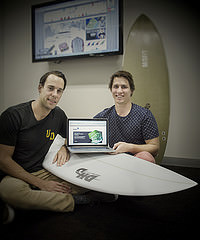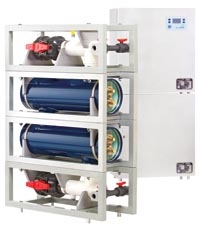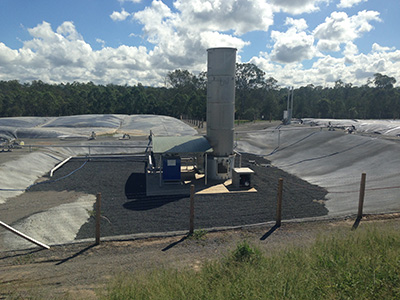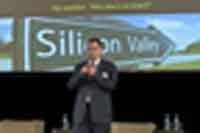AGRICULTURAL ROBOTS invaded the recent Innovation Series event in Brisbane – not in numbers but certainly in scope for their possibilities.
In an event that focused on the economic opportunities Australian agribusiness innovation could generate – titled Agriculture, Robotics & Collaboration a recipe for Global Success? – agricultural robots (agbots) were demonstrated as a new arm of Australian agricultural science rather than science fiction. 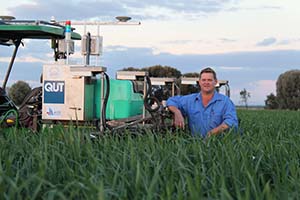
Agbots happen to be a new field of endeavour for Central Queensland farmer Andrew Bate, who has been working in collaboration with QUT and the Australian Centre for Field Robotics to develop robots as, he said, “an enabling technology to do things farmers could not do before”.
The agbot future, as Mr Bate envisions it, involves swarms of small task-specific robots managing vital processes in ways that humans cannot. Mr Bate’s agbot development company, SwarmFarm Robotics, illustrates his vision – swarms of agbots conducting plant and soil maintenance and improvement tasks such as bug and weed removal, at any hour of the day or night and in any weather conditions – superseding current chemical treatment systems.
Mr Bate said the ‘big’ automation programs for Australian farmers had gone about as far as they could go, with ploughing, planting and harvesting systems now so big that they created a range of counterproductive problems of their own. In fact, it was while considering how to deal with the deep tracks cut across his land from these massive systems that Mr Bate began to contemplate better solutions through agbots.
The traditional methods for boosting production, such as chemical treatments and doing everything on an ever-larger scale, were not cutting it anymore, Mr Bate said. He said Australia, because of its previous herbicide use, now had the “unenviable record” of having the second highest number of herbicide resistant weed species of any country.
“The cost (of extra herbicide use) to Australia’s grain industry alone is estimated to be $200 million a year,” Mr Bate said. “The technology that pushed agriculture for the past 20 years has plateaued. Along the way we have forgotten about slow farming – slow, accurate, precise – we have been dining out on a fast food burn.
“Thinking about this was how I got onto the world of agriculture, robotics and collaborations,” he said.
Mr Bate showed Innovation Series attendees images of massive modern farming equipment, including a 300 horsepower, 36m wide spraying machine used on his family’s Bendee Farm. He pointed out that every second of its operation that machine was passing over 28,000 individual plants.
“All equipment like this is the same,” he said. “You are dealing with wheel widths and there are limits caused by the compaction of the soil and the destruction of crop that results,” Mr Bate said.
“Up until now, more efficient has meant larger and larger, but it’s wrecking the crop production. I’m convinced that every time we go bigger we go backwards.”
Mr Bate began developing a plan for swarms of small robots which could, if necessary, operate on an individual plant improvement basis. He felt the capability to do this was the Holy Grail of farm productivity and long-term sustainability.
“We want to slow down, assess every individual plant and tend to its exact needs on a plant-by-plant basis. This may mean applying fertiliser or fungicide only to plants that really need it, rather than applying treatment to entire areas of the field.
“Small robots also reduce the soil compaction (of current large machinery). We are talking about machines that weigh a couple of hundred kilos rather than a 21 tonne spray rig.”
Mr Bate embarked on a global search for such technologies, focusing on the United States where, he figured, there must be developments that could be brought back to Australia and adapted. Most of that research turned out to be directed at military and mining applications. He met with Hugh Durant-White from the Australian Centre for Field Robotics – now chief executive of NICTA – who introduced him to a fledgling program at Queensland University of Technology (QUT) in Brisbane, which was set to lead the world in agricultural robotics development.
Mr Bate’s swarm robotics system could form the experiential cornerstone of new QUT research area, headed by Peter Corke, it was realised, and an Australian Research Centre grant was successfully sought. 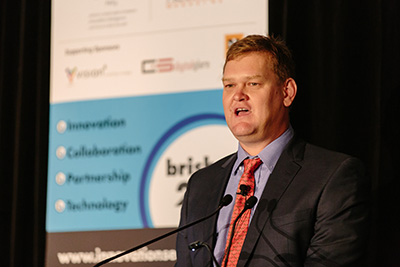
Mr Bate said robotics had the potential to dramatically improve the way we produce food, from managing microbiology in the soil through to how sunlight is absorbed into plant leaves.
“This is pull research, not push research,” Mr Bate said, describing his own family farming business as always being “an early adopter” of new technologies. The difference this time was that he was determined to fit the new technology to meet the farming problem, rather than the other way around.
“From the earliest days of industrialisation in agriculture, farmers have talked about the Holy Grail of farming – the driverless tractor,” Mr Bate said. “But in the modern world of agribusiness, the concept of a driverless tractor is already obsolete.”
He was also not overly enthusiastic about drone technologies, which was what many people associated with future farm automation.
“What are we going to use them for?” Mr Bate said. “Precision farming or ‘precision ag’ has been around for more than 20 years. The idea was that we could collect all this crop data and use it to better manage areas of our paddock. Big data may be a new thing in business, but we got it 20 years ago. We have been collecting data – crop yield, grain protein, near infra red images, satellist images, EM (electron microscope) scans – all sorts of data. Most farmers have got hard drives full of this stuff. Lots of pretty maps, but very few are using it for anything useful.
“Pretty much any data that we can get from drones we can already get from a piloted plane at a competitive cost. A thousand dollars will buy a lot of flight time in a piloted aircraft to collect whatever data you want, but few farmers are willing to do this. Still, everyone is excited by drones to collect more data that no-one seems to be bothered to use at the moment.
“More data doesn’t equal more productivity – we already have information overload.”
Mr Bate was more concerned with the direct application of robots to precision tasks.
“What can we do with robots to increase yield, efficiency and improve the environmental impact of farming? The first thing people tend to say to me is that robots will save us so much on wages – but I don’t think so,” he said.
“We already have the labour saving devices now – they are the 36m spray rigs, the 60m planters … It’s getting pretty lonely on the farm – we only have about one person per 5000 acres now, and I don’t think we can do with any less people.”
Instead, Mr Bate said, his research of robotics for agriculture pointed towards agbots that were small, simple, inexpensive with very few moving parts and robust electronic systems. These agbots are all about helping farmers, big or small, to boost production and quality, he said.
SwarmFarm agbots are small, simple machines that do simple tasks very well. They are at a cost level accessible to all farmers and are able to be adapted to local conditions – plus, importantly, they are scalable.
“While governments in developing nations are eager to become self-sufficient, or at least produce as much food as they can, other nations are becoming more concerned about sustainability, environmental impact and the quality and health of the food they are consuming,” Mr Bate said.
“A potato farmer in Russia will want to have robots perform different tasks to a potato farmer in Victoria.”
He described a new microwave technology developed at the University of Melbourne that can be used to kill weeks accurately and efficiently. This is the kind of technology that SwarmFarm agbots could utilise, identifying weeds, ‘frying’ them, then moving on to the next one. Suitably powered, such robots could spend their entire time in the paddock.
“Even more exciting, I think, are the ideas that we have not even thought of yet – ideas that we will start having when they are out in the field and people start thinking more laterally about applications for robots,” Mr Bate said.
Mr Bate and his SwarmFarm team are working with two QUT PhD students, Patrick Ross and Andrew English, along with project leader Dr David Ball. The project is also partnered with the Australian Centre for Field Robotics with Dr David Fysh and PhD student Tom Patten.
While most of the work so far has centred on object avoidance systems and swarm techniques, progress has been rapid and the project is just months away from releasing model prototypes. Mr Bate is eager to see Queensland lead the world in swarm farming agbots.
“Robots will give us increased yields, increased efficiencies and better environmental outcomes. Simple.”
CSIRO SEES GROWING OPPORTUNITIES
As the world ‘centre of gravity’ for nations’ gross domestic product (GDP) shifts from what was decades ago the Middle East to the balance point of India and China in the decades to come, Australia will be presented with a magnificent opportunity in agribusiness.
That is where research by the CSIRO points, according to its Futures Division leader, Stefan Hajkowicz, who focused at the Innovation Series on the CSIRO-identified megatrends as they affect Australian agribusiness. 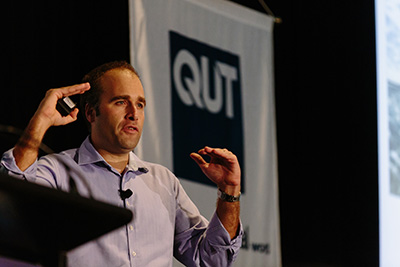
The development of robotics and farm automation also fits directly into the strategic view of Australia’s agribusiness future, Dr Hajkowicz told the Innovation Series event.
He said the kind of automation and artificial intelligence that will come through to assist the agribusiness sector will create opportunities yet to be imagined.
Dr Hajkowicz gave as an example of such possibilities the IBM DeepQA team experiment in computing which eventually produced a robotic intelligence that competed with, and often defeated, the US’s Jeopardy! television quiz champions.
Named ‘Watson’, the computer intelligence did achieve its aim – analysing natural language questions and content well enough and fast enough to compete and win – and now it is being re-assigned to examine other fields.
“When it first began in 2005 it was a non-starter, it was hopeless, and it couldn’t get there,” Dr Hajkowicz said. “But in the space of four or five years they had improved it so much that it could beat almost all of the contestants.
“Now a computer can always win at Jeopardy! no matter what, and soon this thing is going to be plugged into the health care system so that a nurse can talk to it in natural language and ask it questions for a complex diagnoses. There will be a time pretty soon where it gets plugged into Siri and it then starts to significantly change what the power of our iPhone is.”
Dr Hajkowicz said the next phase could be to set such computers to examine challenges in agribusiness – and the day may come in which such powerful computing would be available to farmers to assist with local problem solving.
Dr Hajkowicz likened Australia’s challenges in areas such as resources and agribusiness to that which the famous US steel centre, Pittsburg, overcame after the collapse of its industry in the 1980s. Pittsburg transitioned – painfully, but successfully, “from steel maker to steel technology,” he said.
He said as the steel markets collapsed in the 1980s, Pittsburg turned to the intellectual assets it had in metallurgical research and steel making techniques to make the transition.
“It went from selling ingots to ideas,” Dr Hajkowicz said. “That kind of transition is there for the Australian economy, potentially.”
He said such a transitional opportunity directly applied to the agribusiness sector, where Australia had a golden opportunity to develop and export its technologies and systems to the world.
From Dr Hajkowicz’s research, Australia could quickly take advantage of global trends in food production, but it had to do more than just produce more food. Australian farmers had to understand the direction of food requirements in developing markets and be a step ahead of those trends.
For example, he said, “China is now into a high protein (intake) demand area – and this takes a lot more land” than, say rice production. CSIRO research showed clearly that as communities develop economically, their demand for more protein content, and better quality foods, accelerates. China has reached that point in the past decade.
An indication of the challenges ahead came from the dramatic hikes on food prices that came about in 2008, Dr Hajkowicz said, tracked by the United Nations Food and Agriculture Organization.
This was a period in which the unintended consequences of turning grain production over to supporting biofuels development contributed to hundreds of millions of people slipping into malnutrition.
CSIRO and UN Food and Agriculture Organization research showed food prices had been relatively stable until 2008, when energy prices went up, biofuel production soared and that meant cuts to food output. Another factor at the time was export restrictions which caused panic buying in some markets.
Dr Hajkowicz said one research set attributed the 30 percent spike in food prices almost entirely to biofuel subsidies, while rising oil prices also fed into that 2008 food price shock. Food prices, he said, are inextricably connected to oil prices.
“Modern agriculture, we know, in effect turns oil into food,” Dr Hajkowicz said. “We need it for machinery and for fertiliser (production) – while urbanisation played a role, but not a particularly significant one – and the rise in incomes in China became a factor.”
Dr Hajkowicz said a very worrying trend that also emerged at the time was speculation in food futures derivatives markets at levels not seen before.
Of further concern, and something which should always be on Australia’s radar, was that high food prices destabilise communities and can lead to armed conflict. Research into the links between global food prices and deaths due to riots and protests show a clear correlation.
“Some of those incidents show 10,000 plus deaths, such as in Libya for example,” Dr Hajkowicz said. “The research shows that above a certain food price we are assured of getting serious riots with mortality and those riots are then connected to the destabilisation of the political systems, the dysfunction of markets and whole lot of political and community breakdown as a consequence.
“So high food prices have an impact beyond the humanitarian level – they destabilise our work and are an underlying source of armed conflict.”
The upside, Dr Hajkowicz said, was that high food prices caused a reaction to meet the need, although with a lag, and he pointed out how Australian grain farmers responded rapidly and profitably to the global shortages of late last decade.
Dr Hajkowicz said this was an area that needed to be considered by the G20 countries and he suggested it was time for the G20 to develop an open “free and fair” food market, where there were no distortions. He said the market forces left alone had proven over time to be self-stabilising.
Australia should probably look to New Zealand for a lead on its agribusiness opportunities, Dr Hajkowicz said, because New Zealand and in particular the dairy farmers co-operative Fonterra, had managed to develop a national brand that ‘owned’ fresh and nutritious food – especially in the dairy sector and particularly in China.
“China is becoming a big food importer,” Dr Hajkowicz said, “but not everything. If you are trying to sell them garlic, you won’t do well, because most of the garlic we actually sell in Australia comes from China.
“However, if you are selling them dairy, wine, olive oil, tropical fruit, grains, chicken and pork and seafood, you are going to do incredibly well, because these are big growth markets.
“I don’t think we are coming close in Australia tapping into and connecting with these massive growth markets. China is the standout, but there is India, there is South Korea, there is Singapore … there is a lot of movement across the Asia region. I think this is one of the opportunities we are letting slip away.”
Fonterra, however, has seized the opportunity and is a clear example to Australia on how it can be done. Interestingly, Dr Hajkowicz said, Fonterra probably succeeded because it was one large company and could react decisively, swiftly, and all the while maintaining exceptional levels of quality in all its products.
Its big opportunity was the domestic poisoned baby milk scare in China, which drove parents to look for a reliable clean and green alternative offshore. New Zealand’s Fonterra delivered and has innovated ever since.
“Australia can position itself to meet all of those areas, if we are smart about it.”
“The challenge is for Australian agriculture to start to do this,” Dr Hajkowicz said. “Pick the right products … which the new emerging Asian markets can get in to.”
Dr Hajkowicz said the problem was that Australian agribusiness was “not on the front foot”.
“Australian agriculture is good at what it does, it’s highly efficient but it is a price taker. We take what price the world is giving is and shovel the stuff off, but we don’t go out there and actively build new markets opportunities.”
Health is going to be the major driver of what people are going to choose for food, according to CSIRO’s Megatrends research.
“For the food of the future and what people are going to want to eat, health is going to be so much more of an important driver,” Dr Hajkowicz said. Developed societies had only recently become aware of a tapering off in life expectancy due to the rise in Type 2 Diabetes, which can cut 10 to 15 years off a person’s life. This pointed to a substantial rise in the use of functional foods to improve health, Dr Hajkowicz said.
An example was CSIRO’s own development of a functional food, BarleyMax.
“We know from research over time that wholegrain cereals reduce the risk of heart disease and stroke in males by about 20 percent,” Dr Hajkowicz said.
“Organic food (popularity) is also growing, and this is another dimension to the experiential component – we want to know if it’s fair trade, we want to know the environmental footprint, and we want to have a feel good moral factor about it when we buy it.”
Dr Hajkowicz said the world was experiencing unprecedented income growth and that had a major impact on the purchase of food as people became wealthier.
“Protein is getting on the menu – as we get more income growth we want more protein,” he said. “What’s one of those? Fish. Asian people do eat more fish protein than the rest of the world.”
He also pointed out studies over 30 years revealed an inverse proportion of myocardial infarction – heart attacks – in people as fish consumption grew.
“Health is a much more important driver of global food now and into the future,” Dr Hajkowicz said. “We can respond to these needs via functional foods.”
“The supply and demand factors are in place to provide a boom condition for Australian agriculture. If we are smart about it, we know how to connect with these markets.
“The big one is the consumer demand for healthy food, plus also the feel-good factor and the whole emotional connection to food.
“Australia can get a quality differentiator into those markets and can crack it. Food security is going to be important for global stability.
“Food ethics are important because food is all about making us healthy and happy.”
Australia needs to develop a quality positioning on its food and agricultural products, he said.
Dr Hajkowicz said attending a recent Diversify Mackay forum, in which strategies were put forward to diversify the regional economy away from resources dependence, highlighted the bright future for food and agriculture.
“At the Diversify Mackay forum I can remember thinking at the time that what we really need is a Diversify Australia approach at a higher level. I think that is a challenge – and the point we are at.”
*
The Innovation Series, started in Queensland in 2004, is a unique Australian forum convening researchers, industry and government to address and discuss leading developments in sustainability, while also encouraging the exchange of ideas and inviting new collaborations.
The Innovation Series is organised by Zernike Australia and partnered by the Australian Institute for Commercialisation, QUT, Fisher Adams Kelly, AusIndustry and Business Acumen magazine.
The next Innovation Series Brisbane event is on August 8 at the Stamford Plaza hotel covering the topic Big Data: A Catalyst for Business Success. The event features Quantium director Tony Davis and SIBA chair in spatial information at QUT, Tim Foresman.
www.innovationseries.com.au
ends
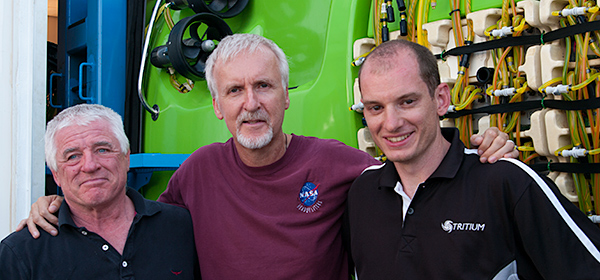

 How to resolve AdBlock issue?
How to resolve AdBlock issue? 